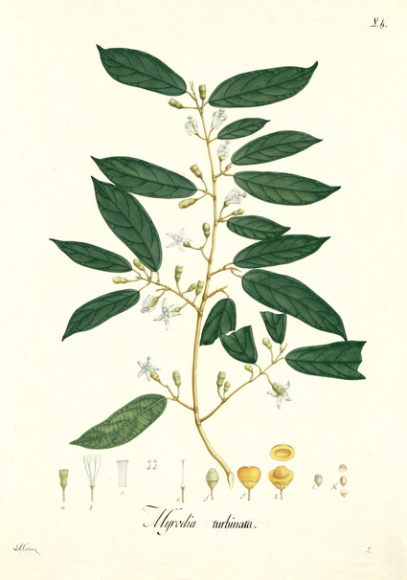
Taken from José Celestino Mutis – Real Expedición Botánica al Nuevo Reino de Granada, t. 2170 (1783-1817), Public Domain
Perhaps scientific understanding and artistic imagining are different aspects of the same impulse.
And humanity’s great understanders and imaginers are inspired from similar sources.
Jack Klein
That science informs art is patently obvious: painters and sculptors studying anatomy to depict a body, poets and musicians using math, who manage to move us all.
The reverse equation is less obvious, however, and more intriguing: trips to the moon were projected on papyrus (or whatever Greek author Lucian of Samosata wrote on in 160 AD when he came up with the idea[1]), 1800 years before they took place in space.
And then there’s the practice where both approaches interact in parallel, in the search for… beauty? truth? Rana Bose’s essay, “First principles and aesthetics,” offers incisive reflections on the potential correspondences between these two objectives. Yet even making a distinction between formal beauty and veracity may be irrelevant.
Celestino Mutis was an 18th-century Spanish surgeon, astronomer and botanist. In the aim of investigating the plants of Colombia for his Flora del Reyno Unido de Granada,[2] he closely directed the work of more than 40 painters, many of whom joined his trans-Atlantic expedition. A school of drawing and painting was created just for this project in Mariquita, and as some of the Spanish painters fell ill, artists from Quito joined the enterprise, along with local painters from Santa Fe, Cauca and Popayán… and other waves of newcomers from Madrid. Accurate depiction was the goal, and in order to do justice to the exuberant natural palette of the region, the painters used soil, fruit juices, bark, saffron, achiote, palo de Campeche, copper oxide, the grana cochinilla insect, indigo and many more vegetal and mineral pigments whose recipes were carefully controlled by Mutis himself. Art or chemistry?
This issue of Montréal Serai was already underway — that is, da Vinci had already been evoked in the essays of Maya Khankhoje and GG Jolly, Veena Gokhale had already submitted her insightful review of the South Asian Film Festival of Montréal, and the team had unanimously welcomed Marie Thérèse Blanc’s empirical and poetic account of the death of her father — when I came across Amanda Woolrich’s animated engravings inspired by the work of naturalists like the Count of Buffon (1725-1723) and Alfredo Dugès (1826-1910), projected on the thick walls of the Centro Cultural San Pablo in Oaxaca, Mexico.
Meanwhile, poets were inundating the Serai submissions inbox. Their verses evoking spleens and aortas (Cyril Dabydeen), radioactive boars (Ilona Martonfi), gravity (Louise Carson), Cartesian space (Paris Sea) and cells (Maya Khankhoje), and reflecting on the dreamworld of winter (Dinh Le Doan), yearning (Gina Roitman), wildness (Mary Dean Lee) and dementia (Brenda Linn), remind us that the intersections of art and science form the borderlines of pretty much all we can know… or feel.
Oleg Dergachov’s cartoon of three (narcissistic?) snails looking at an abstract representation of the spiral they carry over their soft bodies may summarize “in a snailshell” much of what the authors in this issue have to say. In a similarly teasing mood, physician Jack Klein recalls how, at the turn of the 20th century, Ignaz Semmelweis “lost his marbles after a long and fruitless quarrel with the German medical establishment regarding the need for handwashing after dissecting cadavers before delivering babies!” In that vein (pun intended), the provisional truths of art seem far less dangerous—and far more enticing.
[1] In his book La ciencia en la literatura, published by the Universitat de Barcelona, Xavier Duran lists 400 literary works that illustrate the close relationship between science and literature.
[2] Antonio González Bueno, “La Naturaleza en imágenes. Los pintores de la Flora del Nuevo Reyno de Granada (1783-1816),” en José Celestino Mutis en el bicentenario de su fallecimiento (1808-2008) (B. Ribas Ozonas edit.), Monografías de la Real Academia de Farmacia, 26, Madrid. Available at: https://www.analesranf.com/index.php/mono/article/download/961/958